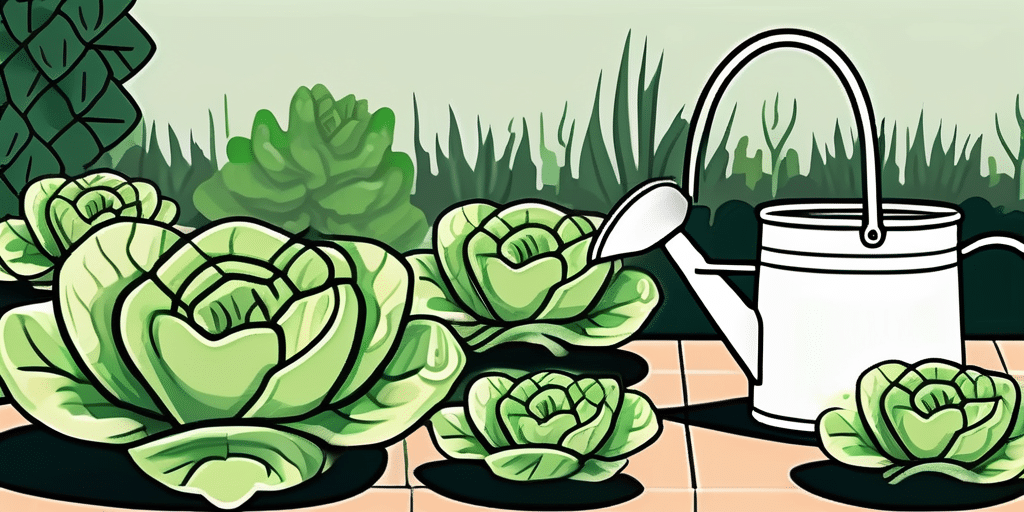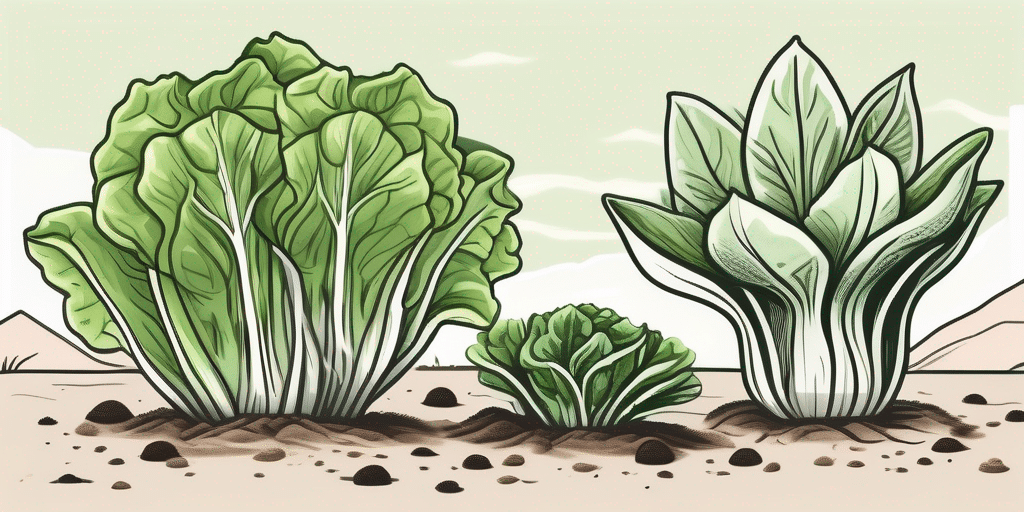If you’re a lettuce lover in Missouri, Sucrine Lettuce is definitely a variety you should consider growing in your garden. With its unique flavor and crisp texture, Sucrine Lettuce is a favorite among gardeners and chefs alike. In this article, we’ll cover everything you need to know about growing Sucrine Lettuce in Missouri, including when to plant, how to grow, and when to harvest.
Climate & Hardiness Zones in Missouri
Before we dive into the specifics of growing Sucrine Lettuce, it’s important to understand the climate and hardiness zones in Missouri. The climate in Missouri is considered to be a mix of humid continental and humid subtropical, with hot summers and cold winters. The state falls under USDA hardiness zones 5a to 7b, which means that temperatures can range from -20°F (-29°C) to 10°F (-12°C) in the winter.
Missouri’s diverse climate and hardiness zones offer a wide range of opportunities for gardeners and farmers. The humid continental climate in the northern part of the state brings cold winters and warm summers, ideal for growing cool-season crops like broccoli and carrots. In contrast, the humid subtropical climate in the southern region provides a longer growing season, allowing for the cultivation of heat-loving plants such as tomatoes and peppers.
Furthermore, Missouri’s varying topography, including the Ozark Mountains in the south and the Missouri River Valley in the north, contributes to microclimates within the state. These microclimates can create pockets of slightly different growing conditions, offering unique opportunities for experimenting with different plant varieties and growing techniques. Whether you’re a novice gardener or a seasoned farmer, understanding Missouri’s climate and hardiness zones is essential for successful and bountiful harvests.
When to Plant Sucrine Lettuce in Missouri
Knowing the right time to plant your Sucrine Lettuce is crucial for a successful harvest. In Missouri, the best time to plant Sucrine Lettuce is in the early spring, as soon as the soil is workable and the threat of frost has passed. This usually occurs around mid-March to early April. However, if you’re feeling adventurous and want to extend your lettuce-growing season, you can also sow Sucrine Lettuce seeds in late summer or early fall for a fall harvest.
When planting Sucrine Lettuce, it’s important to choose a location that receives at least 6 hours of direct sunlight each day. The soil should be well-draining and rich in organic matter. It’s also a good idea to perform a soil test to determine the pH level and make any necessary adjustments to ensure optimal growth.
Once your soil is prepared, you can plant Sucrine Lettuce seeds directly into the garden beds. Sow the seeds about ¼ inch deep and space them 6 inches apart. If you’re planting in rows, make sure to leave a distance of about 12 inches between each row. After sowing the seeds, gently water the area to keep the soil evenly moist.
Now, let’s dive a little deeper into the process of starting Sucrine Lettuce indoors before transplanting it into the garden. This method can give you a head start and help you get a jump on the growing season.
If you prefer to start your Sucrine Lettuce indoors and then transplant it into the garden, you can start the seeds 4 to 6 weeks before the last expected frost date. This will give the plants enough time to establish themselves before being exposed to the outdoor elements. Simply sow the seeds in seed trays or containers filled with seed starting mix, keeping them moist and providing adequate light until they’re ready for transplanting.
When starting Sucrine Lettuce indoors, it’s important to mimic the outdoor conditions as closely as possible. Ensure that the seed trays or containers are placed in a warm location with plenty of sunlight or under grow lights. Maintaining a temperature of around 70°F (21°C) will help the seeds germinate faster and encourage healthy growth.
As the seedlings grow, it’s crucial to provide them with proper care. Keep the soil consistently moist, but avoid overwatering, as this can lead to root rot. Once the seedlings have developed their first true leaves, you can start fertilizing them with a balanced liquid fertilizer diluted to half strength. This will provide them with the necessary nutrients for vigorous growth.
When the threat of frost has passed and the seedlings have grown to a suitable size, they are ready to be transplanted into the garden. Harden them off gradually by exposing them to outdoor conditions for a few hours each day, gradually increasing the time over the course of a week. This will help them acclimate to the changes in temperature, wind, and sunlight.
When transplanting the seedlings, make sure to dig a hole that is slightly larger than the root ball. Gently remove the seedling from its container, being careful not to damage the delicate roots. Place the seedling in the hole and backfill with soil, firming it gently around the base of the plant. Water thoroughly to settle the soil and provide the newly transplanted seedlings with a good start.
By starting your Sucrine Lettuce indoors, you can enjoy an extended growing season and have a bountiful harvest. Whether you choose to sow the seeds directly in the garden or start them indoors, with proper care and attention, you’ll be rewarded with crisp and delicious Sucrine Lettuce to enjoy in your salads and sandwiches.
How to Grow Sucrine Lettuce in Missouri
Now that your Sucrine Lettuce seeds are planted and beginning to sprout, it’s time to focus on growing them into healthy, vibrant plants. Here are the key steps to effectively grow Sucrine Lettuce in Missouri:
- Watering: Sucrine Lettuce prefers consistent moisture, so it’s important to water them regularly. Aim to provide about 1 inch of water per week, either through rainfall or manual irrigation. Avoid overwatering, as this can lead to disease and root rot.
- Fertilizing: While Sucrine Lettuce can tolerate a wide range of soil conditions, it benefits from nutrient-rich soil. Incorporate compost or well-rotted manure into the soil before planting to provide a natural source of fertility. You can also supplement with a balanced organic fertilizer during the growing season.
- Thinning: When your Sucrine Lettuce seedlings reach a height of around 2 inches, it’s time to thin them out. Space the plants about 6 to 8 inches apart to allow for proper air circulation and to prevent overcrowding, which can lead to disease development.
- Weed Control: Keep the area around your Sucrine Lettuce plants free from weeds, as they can compete for nutrients and water. Regularly hand-pull any weeds that emerge or use organic mulch to suppress weed growth.
- Pest Management: Sucrine Lettuce is generally resistant to pests, but it can still fall victim to common garden pests such as aphids, slugs, and snails. Monitor your plants regularly and take appropriate measures, such as using organic pest repellents or physical barriers, to keep pests at bay.
- Shading: In the hot summer months, Sucrine Lettuce can be prone to bolting or going to seed prematurely. To prevent this, consider providing some shade to your plants during the hottest part of the day. This can be achieved by using shade cloth or planting taller crops nearby to provide some natural shade.
When to Harvest or Pick Sucrine Lettuce in Missouri
After all your hard work tending to your Sucrine Lettuce plants, it’s finally time to enjoy the harvest. Sucrine Lettuce is typically ready to be picked around 45 to 60 days after planting, depending on growing conditions and your desired size of the leaves.
To harvest Sucrine Lettuce, simply use a pair of clean garden shears or a sharp knife to cut the leaves at the base of the plant. You can choose to harvest the outer leaves as needed, allowing the inner leaves to continue growing, or you can harvest the entire head of lettuce at once.
Remember to wash your harvested Sucrine Lettuce thoroughly before consuming it. Store the washed leaves in the refrigerator, wrapped loosely in a damp paper towel or stored in a perforated plastic bag, to maintain freshness.
Frequently Asked Questions
Q: Can Sucrine Lettuce tolerate hot temperatures in Missouri?
A: While Sucrine Lettuce prefers cool temperatures, it can still tolerate moderate heat. Providing shade and regular irrigation during hot periods can help prevent premature bolting.
Q: Are there any common diseases that affect Sucrine Lettuce?
A: Sucrine Lettuce can be susceptible to diseases such as lettuce downy mildew and lettuce mosaic virus. Practicing good garden hygiene, including sanitation and crop rotation, can help prevent disease outbreaks.
Q: Can I save seeds from my Sucrine Lettuce plants to replant next year?
A: Yes, you can save seeds from your Sucrine Lettuce plants. Allow the plants to bolt and go to seed, then collect the dried seed heads and store them in a cool, dry place. However, be mindful that lettuce is known for cross-pollination, so there is a chance that the saved seeds may not produce true-to-type plants.
Growing Sucrine Lettuce in Missouri can be a rewarding endeavor. By following the proper planting and growing techniques, you’ll be able to enjoy the fresh taste and crunch of Sucrine Lettuce straight from your garden. So go ahead, get your hands dirty, and savor the satisfaction of growing your own delicious lettuce!
Join How to Grow Everything for More Gardening Success!
Ready to transform your green space into the garden of your dreams? Subscribe for free to How to Grow Everything and gain access to personalized gardening advice tailored to your Missouri grow zone. Whether you’re a beginner or an experienced gardener, you’ll find invaluable tips to help your Sucrine Lettuce and other plants thrive. Plus, enjoy special offers and the best gardening tips delivered straight to your inbox – all 100% free, from our family to yours. Don’t miss out on creating your perfect garden. Subscribe now and let’s grow together!






